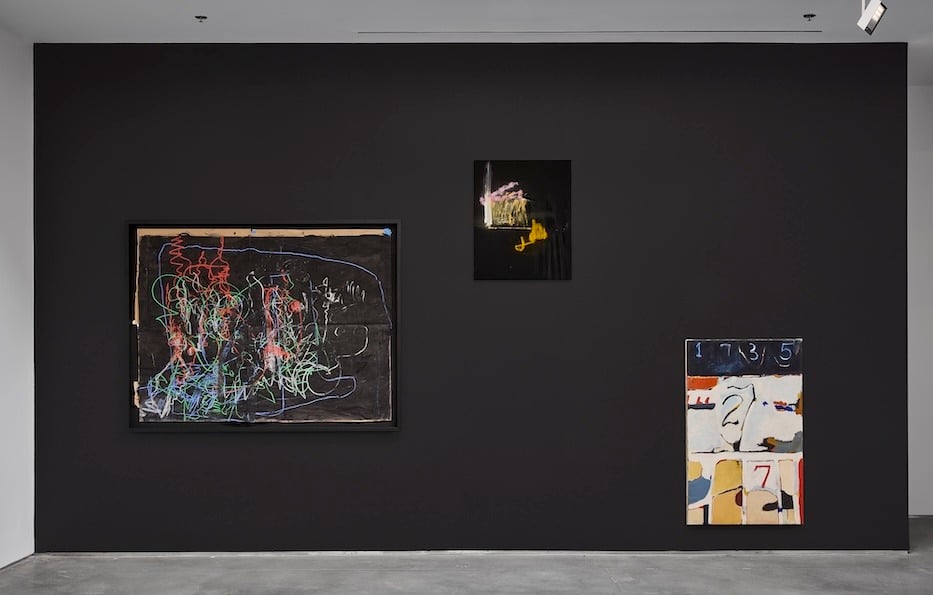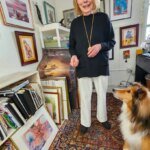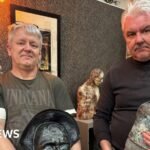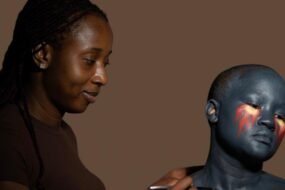

Awilda Sterling-Duprey: Aesthetics of dis-order. Photo by Chris Gardner. Courtesy of NXTHVN.
A trail of white fingerprints leads to a tangle of lime green and white pastel marks on a large piece of black paper. Small magnets affixing this work directly to the wall position it at a steep angle so the top right corner of the composition reaches closer to the ceiling above the white wall. Movement is implied both in the off-kilter placement of the piece and inside the work’s gestural scrawls and coils.
With its looming presence, Blindfolded Series #1 is an anchor in the solo presentation of works by NXTHVN’s visiting artist Awilda Sterling-Duprey, on view at NXTHVN through Nov. 24. The show, Aesthetics of dis-order, surveys the artist’s engagement with abstraction from the 1970s to the present and is the first to present this lineage through a range of works, mostly on paper.
A large glass case containing news articles and other ephemera helps to contextualize the career arc of Sterling-Duprey, who was born in San Juan, Puerto Rico in 1947. She is one of the country’s seminal artists and a founding member of the first experimental dance collective in Puerto Rico called Pisotan.
The enclosure also features visual documentation of early cardboard studies that presumably no longer exist. Collectively, these materials work a bit too hard to impress their importance on viewers—an effort that could be alleviated by a more expansive display of artwork.
.jpg?width=933&height=627&name=Aesthetics%20of%20dis-order%20(3).jpg)
.jpg?width=933&height=562&name=Aesthetics%20of%20dis-order%20(1).jpg)
Awilda Sterling-Duprey: Aesthetics of dis-order. Photo by Chris Gardner. Courtesy of NXTHVN.
Sterling-Duprey’s first foray with abstraction was in the 1960s when the genre was unpopular in Puerto Rico, but the earliest painting in the show, As yet untitled, is from the following decade. Hanging low on the back wall, which is painted a matte black, numbers emerge from the bands of flat color. This relatively tame painting, with a whiff of Jasper Johns, is an outlier within the otherwise exuberant exhibition.
To the left are two works from the artist’s Blindfold series—the most interesting body of work here. While all three paintings on the back wall are displayed at unconventional heights, the frenzy of Sterling-Duprey’s markmaking within the first pair rebounds around the gallery. These two works were constructed while the artist was blindfolded, as the title implies.
Sterling-Duprey’s tight loops and jagged gestures are evident throughout the show, though these marks took on new meaning around 2020 with the birth of her Blindfold series. Listening to salsa or jazz, she lets the music guide her movements. Sheets of paper mounted on the surrounding walls capture how her body and hands respond.
This series aligned with a shift in her practice as well as milestones in her career. In the 2022 Whitney Biennial, she painted while blindfolded and listening to jazz during her performance . . . blindfolded. The following year, a 45-minute performance piece by Sterling-Duprey premiered at the John Hess Family Gallery and Theater at the Whitney Museum of American Art. Lacks Criticality coincided with the exhibition no existe un mundo poshuracán: Puerto Rican Art in the Wake of Hurricane Maria. The show considered the responses of artists to Hurricane Maria—followed by political unrest, the COVID-19 pandemic, and other natural disasters—on the fifth anniversary of the catastrophic storm.
Of the Blindfold series, Sterling-Duprey has said, “In the moment, while making those images, I don’t have a sense of what I am doing, but I am enjoying grasping the concept. Abstraction gives me that openness and that freedom; from there, I can go further, be riskier in how I work.”
.jpg?width=933&height=587&name=Aesthetics%20of%20dis-order%20(2).jpg)
Awilda Sterling-Duprey: Aesthetics of dis-order. Photo by Chris Gardner. Courtesy of NXTHVN.
Certainly, dancing and painting while blindfolded may engender some amount of risk, however lacking this quality is from the resultant artworks. Process and product are not synonymous. As standalone objects, Sterling-Duprey’s works track too closely to the aesthetic of action paintings of yore. The jittery energy of her lines can lose its edge when you realize these works were made recently, not seven decades earlier. It’s also true that the rugged and macho aura of that era did not age well.
Many artists—such as the American Abstract Expressionist artist Franz Kline, who was an early influence on Sterling-Duprey—have counted music as an important influence on their process, but Sterling-Duprey adds a twist. Her practice subverts the old hierarchy by making paintings that take a backseat to her performances. You can almost hear the music looking at her work, which seems to be the point: The paintings point to something greater. Sterling-Duprey underscores the improvisational nature of the music by removing her ability to see as she creates.
Whereas photography and video (and there is a video of one of her performances inside this space) often serve to document performance-based works, the paintings become the relic here. In this show, the most intriguing aspect of Sterling-Duprey’s exploration of abstraction is not this type of painterly evidence, but maybe the imagined performances the works evoke.
Awilda Sterling-Duprey: Aesthetics of dis-order continues through November 24, 2024, at NXTHVN, 169 Henry Street, New Haven, CT 06511. On Saturday, October 26, a performance by Sterling-Duprey will be in dialogue with local New Haven musicians.











